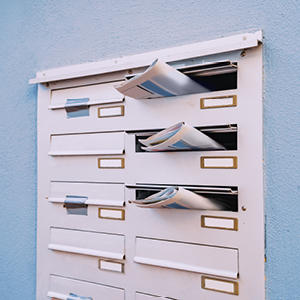From its inherent credibility to its ability to drive meaningful results, print media continues to hold its own in the digital age. Here’s why…
Physical advertising in society dates back millennia, with evidence of commercial messaging being found on ancient papyrus. And in modern times, print marketing has become a cornerstone of the marketing industry, driving awareness, loyalty and those all-important conversions!
But amid the dazzle of digital marketing, where does print fit in?
Ink, paper and purpose
At Denfield, we work with a whole host of print media, from short-form advertising like direct mail, invites and banners to longer-form pieces like magazines, prospectuses and annual reports.
Each of our designers works across digital and print mediums, but one of our Creatives in particular has carved out a reputation for being the go-to girl for major print projects.
With a background in newspaper design, bolstered by 17 years with team Denfield, our Studio Manager and Creative, Lynda Roberts, is a whizz at creating beautiful print designs (underpinned by a perfectly organised template, of course!). An Adobe Certified Professional In Print and Digital Media Publication using Adobe InDesign, she knows all the tips and tricks for creating something extra special.
Here, Lynda tells us why print still holds a unique position!

- Enhanced credibility
Print marketing has an inherent air of trustworthiness. It feels intentional. When a company has committed to presenting information in print, it instantly boosts the feeling of credibility.
What’s more, while ‘fake news’ haunts the online world, print is often perceived as more reliable and authoritative. In turn, this can influence purchase decisions – according to a MarketingSherpa survey, 82% of people rely on print ads when deciding what to buy and 76% of people rely on direct mail.
Print also allows for a personal touch – for example, customised invitations create an experience that feels more premium.
- It’s easy on the eye
There’s something special about print. High-quality printing techniques make colours more vibrant, textures more pronounced and designs more visually captivating. We’ve worked closely with a local printer, Emmerson Press, since before I joined Denfield to ensure every project hits the mark.
From luxurious matte finishes to eye-catching gold foils, print allows for creative choices that simply aren’t possible on a screen. Plus, sustainable choices – like recyclable stock and certified eco-friendly materials – help balance print’s environmental impact.


- In print and permanent
Well-designed prints are often displayed, bookmarked and revisited. The physical presence of a brand book, annual report, folder or prospectus invites deeper engagement. The DMA found that there’s an average response rate of 9% for direct mail campaigns, compared to an average 2.1% response rate for email campaigns. They also found that 9.2% of consumers receiving a direct mail had been driven online.
Of course, permanence is not without its negatives – as the ‘undo’ button isn’t an option once it’s hot off the press. That’s where our expert proofreading team comes in!
Another potential risk of physical marketing is that things can become quickly dated – though we find that most of our printed collateral is intended to go ‘out of date’, like annual reports and invites. For information that is regularly updated, digital definitely has the edge.
- Keeping pages turning
Unlike digital content, which is often skimmed or swiped, print demands attention. Plus, with no pop-up ads or notifications competing for your focus, you can fully immerse yourself.
Physically turning the pages also creates a connection with readers – something that’s harder to achieve in the fleeting digital space. The latest research shows that information is easier to retain when it’s in print: people are 70% more likely to remember a brand they see in print compared to online.
‘Make people want to read it from cover to cover’ was our brief for Chester Zoo’s annual report – and we like to think we nailed the brief! The reports won ‘Best Cover’ at the Corporate & Financial Awards in 2022 and 2023 and also scooped Best Printed Report in 2023. View our full case study here.


- Driving digital engagement
A common mistake I see in print design is people trying to mimic digital trends. Print isn’t for rapid-fire visuals or endless scrolling; it’s for storytelling, clarity and pacing. Overcrowded layouts, tiny type and excessive effects can make reading a struggle.
I therefore pay careful attention to how the eye moves across a spread. There’s no algorithm deciding what gets seen next – just pure design choices guiding the reader.
That said, there are ways we can bridge the gap between the physical and digital worlds, including dynamic QR codes that encourage readers to take the next step online.
Hold it, read it, remember it!
While digital is now the way forward lot of marketing, why put all your eggs in one basket? For certain briefs, print has a credibility, permanence and sensory experience that digital can’t match.
For me, it’s about the tangibility. Much like the ‘Kindle vs books’ debate, it’s about the feeling of having something in your hands or on your desk.
As long as there are brand stories to tell, print will always have a place at the table.
At Denfield, we know which marketing briefs suit print and digital best and where they can work hand in hand to drive more conversions. Want to find out more about our strategy? Let’s chat!
Ready to
work with us?
Want to collaborate?
Work with us
info@denfield.co.uk
Want to say hello?
Call us
01926 881178

